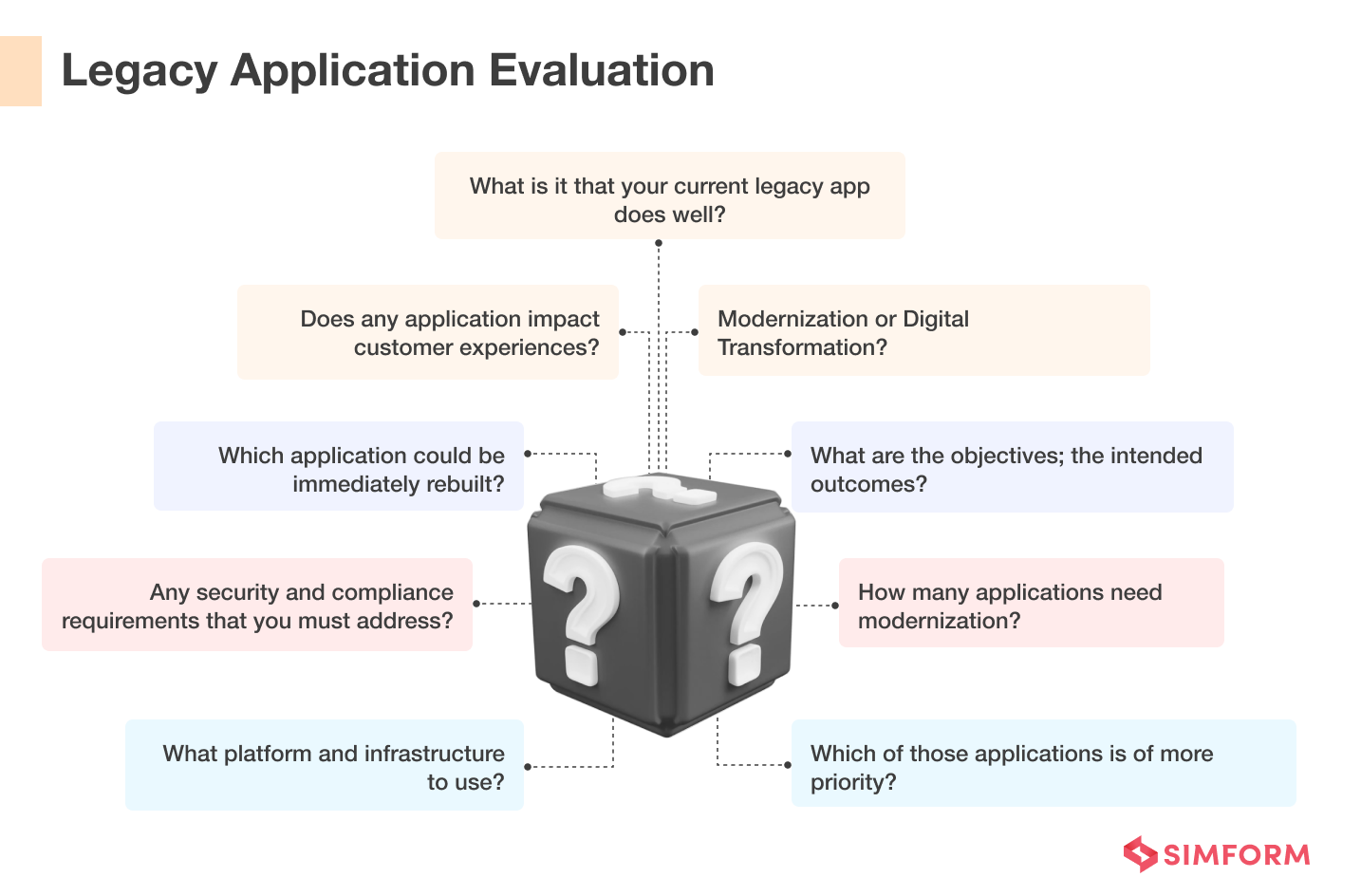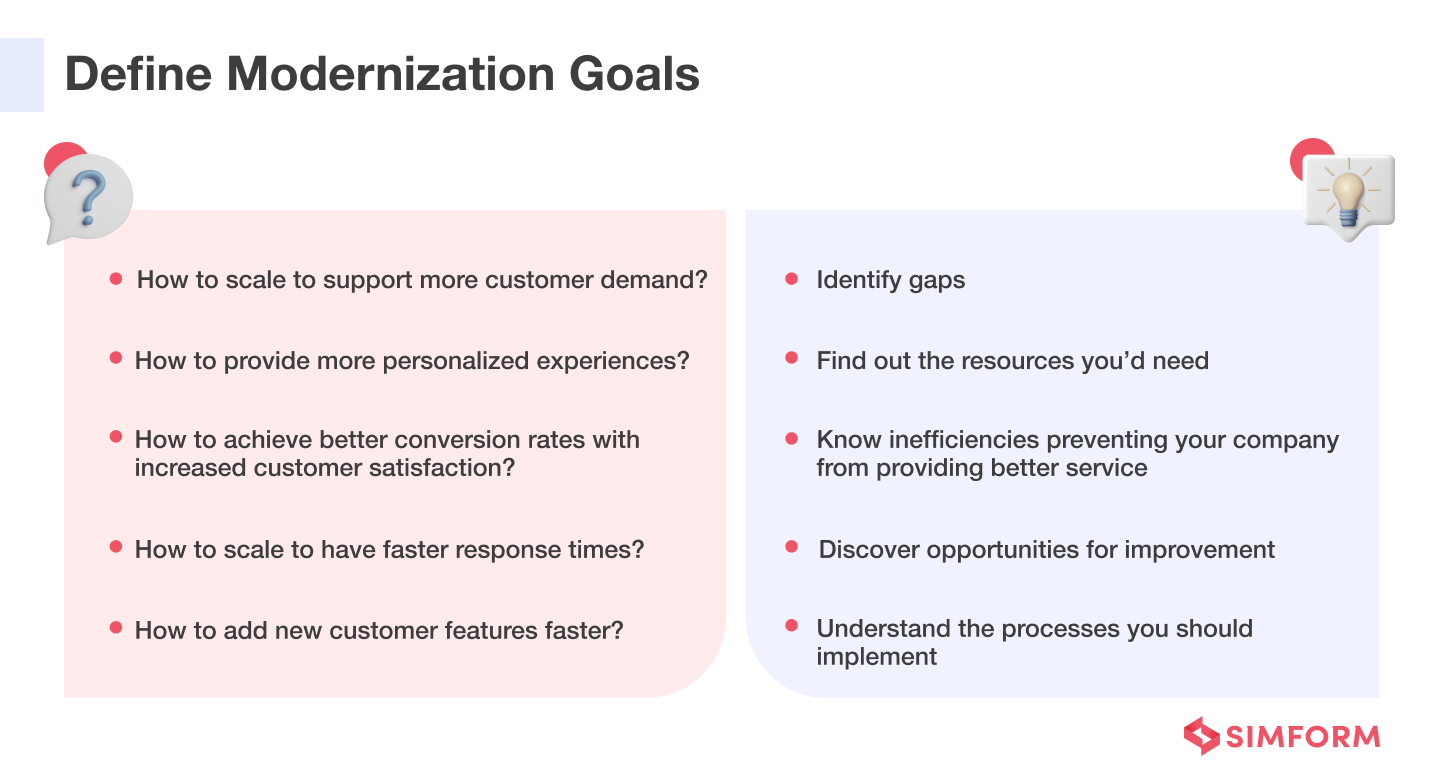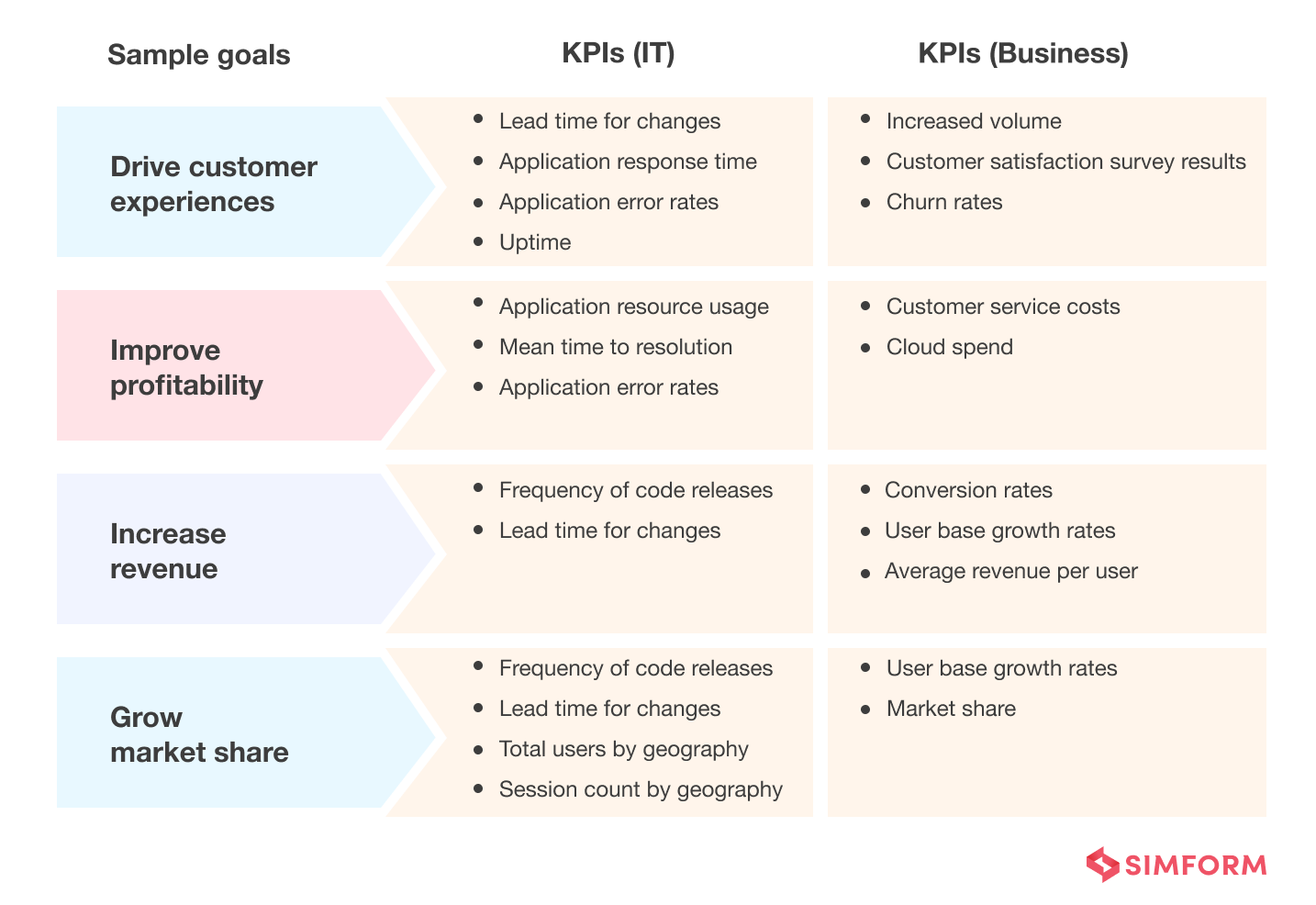Organizations that can achieve peak performance from their core business applications are the ones that can effectively grow, compete, and differentiate themselves. However, many such apps were written quite a few years back, even decades ago.
Over time, most of them start facing various issues, from outdated tech stack to degrading user experience, from data breaches to expensive maintenance. And so, devising an efficient application modernization strategy is necessary to ensure these mission-critical systems stay updated and relevant in this day and age.
This article explores the importance of modernizing legacy applications and the steps to take after deciding to jump on board.
Something you should keep in mind is – application modernization is not just upgrading your current systems or adopting new technologies. It fundamentally changes how you serve your customers, generate revenue, and do your business!
Reasons to modernize legacy applications
When attempting to modernize the applications, you may face a number of challenges like planning the budget, heavy legacy ecosystem, data migration, lack of sufficient knowledge, and more.
Also, as no two apps are the same, the requirements for modernizing each application are also different, like
- Optimize user experience
- Improve application scalability
- Functional improvements
- Increase engineering velocity
- Integration with other apps
- Introduce new delivery toolchains, new access points, new data feeds, or different architectural models
Therefore, it’s essential to build a strategy that perfectly charts your course and gives you answers to these questions –
- Where your organization stands at present
- Where do you want it to be, in what particular time-frame
- How you’d reach there
There’s no doubt about the importance of legacy system modernization. But, exercising caution before proceeding is also essential as these applications are bound to be critical for many business operations. Here are 8 essential steps for an efficient application modernization strategy that would ensure the success of your efforts.
What to consider prior to application modernization?
Businesses strive to keep up with changing customer demands and stay competitive by modernizing their applications. This involves upgrading and optimizing existing applications to enhance efficiency, scalability, and user-friendliness.
However, you need to think about a few questions before initiating a modernization project:
1. Start with WHY
When it comes to application modernization, it’s often helpful to start with “Why?” It is a key for a thoughtful examination of current challenges or potential benefits that could make modernization necessary for your application.
Consider these questions to decide whether your legacy applications require modernization:
- Are the current applications slow to respond?
- Is it challenging to make updates when necessary?
- Do legacy applications integrate well with the latest applications?
- Are new features required that would necessitate application modernization?
Answering these questions can help determine if modernizing the applications would benefit the business.
2. Which are the challenges that prevented modernization?
Despite the increasing adoption of modern solutions, many large-scale companies still rely on old-fashioned business. Although modernization has gained momentum in recent years, a few challenges act as resistance.
To identify likely problem areas and mitigate the impact of challenges, one needs to ponder upon a few things,
- Are your team and infrastructure capable of handling a modernized application?
- How much will the modernization project cost, and how to budget it?
- Do you have the internal expertise required to define and manage such a project?
- Do you have an organization wide buy-in on the project and the new processes it will bring into the system?
3. Do I need to take a tactical approach or a strategic approach to modernization?
To ensure a successful modernization in the organization, you must simultaneously take tactical and strategic approaches.
A tactical approach involves making small changes to your current systems or processes with the goal of improving them in the short term. This approach is generally more focused on immediate problem-solving and maximizing ROI.
In the long run, embracing a strategic approach is beneficial where the organization’s overall growth is crucial over a faster ROI. By creating a transition strategy alongwith your modernization service provider, you can make well-informed decisions about the approach that best suits your project requirements.
4. How do I train or build a team for transformation and future-readiness?
Training employees is essential to harness the potential of legacy application modernization programs fully. Although building such a team is challenging, organizations can use a few ways to prepare a future-ready team:
- Internal / External Training: Organizations can provide hands-on training to their employees so that they can get familiar with new technologies.
- Outsourcing: Organizations should outsource the tasks to experts in the field rather than wasting their time and resources to train employees for new developments every time.
An 8 Steps Application Modernization Strategy
1) Evaluate your application portfolio with the right questions
As mentioned, every application modernization project is bound to face some challenges, which, when neglected, can result in costly mistakes and delays.
The image below outlines the questions that can help you identify the required funds or resources, the skills to deliver the project, and the complexity of implementing technologies. Accordingly, you can minimize the risks and achieve the maximum value from your modernization initiative.

The legacy apps that do not meet the latest criteria for – business value, business fit, and agility, need to be upgraded to enhance business value. Also, if there are signs indicating the need for modernization, such as the use of complex technology or compromised security, compliance, support, and scalability, it’s time to take a plunge.
2) Prepare everyone for a massive cultural shift
Application modernization implies a huge organizational culture shift, as most employees prefer to work with specific technologies and tools. The sudden shift to new technologies and workflows might affect their sense of security and stability and cause some disruption. Not only that, but the leadership teams also need to be convinced of the necessity of initiating modernization projects and the spending it would require.
Because ultimately, they are responsible for sharing their vision behind the transformation with employees. Getting employees on board is possible with a few strategies, like
- Sufficient resources/training
- Optimized timing
- Open communication
- Encouragement for active participation
An AI-powered solution helps decision-makers in analyzing and consolidating actual complexity measurements. With such a data-driven approach, the top of the organization can prioritize and plan a robust modernization strategy. And when employees can also see the benefits of application modernization based on real analysis data, organizations can achieve successful employee buy-in as well.
3) Invest in the right tools & technologies early in the process
Analysis of mainframe code gives an idea of inter-relationships, dependencies, and complexity. Plus, an accurate assessment of the associated risks and complexity from early on lays the foundation for successful legacy modernization.
- What cannot be measured cannot be modernized. First, you should focus on the tech debt of the candidate application. Tools are available in the market that can precisely point out the source of debt and also measure the negative effect it might have on innovation.
- New AI-powered solutions can measure application complexity depending on dependency entanglements and code modularity. They can also measure the risk of changes that may impact stability. When aggregated, this data can perfectly measure the overall tech debt level for the applications in question.
- As aging frameworks pose future security and licensing risks, they should be benchmarked for tech debt, risks, and complexity. The correct assessment approach with proper tooling would integrate seamlessly with an automated modernization solution, paving a path for re-architecting, refactoring, or rewriting your applications later in the process.
- Technologies like microservices and containerization essentially enable legacy applications to become more flexible and scalable.
4) Determine budget and get executive sponsorship
The next step has to be getting executive sponsorship for project funding. With all the data you’ve acquired, it will become easier to determine the budget for the modernization initiative.
However, financing app modernization is completely different from traditional IT budgeting, particularly for organizations that extensively use monolithic or legacy applications. Traditional IT budgeting involves relatively consistent amounts with fewer unknowns and variances from year to year. Whereas modernization initiative inherently has a fair amount of uncertainty you must consider while determining the budget.
Modernization is a continuous process of altering an organization’s technology landscape that impacts the entire organization and its budget. And so, you should determine the return on investment (ROI) and total cost of ownership (TCO) to demonstrate the value the modernization project will deliver to the organization. This will also take you a step further in garnering support from decision-makers.
5) Define customer-centric business objectives & modernization goals
Now that you’ve identified the highest priority business-critical applications, you can explore how they can have better performance, reliability, and scalability with modernization.
Depending on your target market, industry, and other variables, you can also know how transforming critical applications can impact churn, market share, profitability, revenue, differentiated customer experience, and more. Accordingly, you can outline IT and business goals with measurable and realistic outcomes.

Your business can have goals to increase revenue, deliver improved customer experiences, improve profitability, grow market share, etc. We’ll come to that again later in the article.
6) Select the optimal application modernization approach
Now is the time to look at the modernization options, which vary by implementation ease, individual’s impact on the system, and the risk involved. You should select one or more that fit your current state environment, motivations, and long-term strategy. Here they are:
Rehost – Moving the application from an on-premise environment to a new infrastructure (physical, virtual, or cloud) without (or very few) modifications to its code, features, or functions.
Refactor – Making significant changes to the source code of an application by splitting monolithic applications into microservices, implementing caching and cluster support, optimizing the most heavily-loaded business logic, moving some data to a NoSQL database, and so on.
Re-architect – Completely rewriting/redesigning your application from the ground up to shift it to a new architecture with greater capabilities.
Rebuild – Building an individual or various components of an application right from scratch to introduce new technologies or fulfill operational requirements while preserving its scope and specifications.
Replace – Analyzing the root cause of the problem and finding the right solution to retire the legacy application.
|
Modernization Approach |
Why |
When to select |
|
Rehost |
|
|
|
Refactor |
|
|
|
Rearchitect |
|
|
|
Rebuild |
|
|
|
Replace |
|
|
No matter what approach you select, you’ll need forethought and expertise to keep your applications and cloud-based data secure.
7) Select the right modernization partner
Application modernization will likely be a lengthy, expensive, and scary affair! Yet, a stable organization within R&D and at the executive level can guarantee the success of the project.
Determining the specific roles for implementing the strategy depends on the project’s particular requirements. Generally, chief architects play a crucial role in leading the initiative with support from C-level executives. Other essential roles in the implementation include financial stakeholders, project managers, technologists, implementation leads, and security and compliance specialists.
However, no organization’s core focus can be on modernizing applications, so no matter how many roles you include, internal teams may not have sufficient skills for the new environment and the transformation as a whole.
This is why identifying an experienced modernization partner is essential to prioritize the activities, minimize the chaos, and drive the initiative toward desired results.
8) Execute and measure changes against your goals
Proactive monitoring of applications and infrastructure positively contributes to increasing software delivery performance. So, if you don’t want today’s modernized application to become a legacy again in the near future, you must treat it as a “continuous modernization” process. Or be prepared to see all those efforts going for a toss! And that we don’t want, of course.
So, when you’re committed to continuous modernization, you must consistently benchmark and measure results. And when following all the steps mentioned above, you’d already have the KPIs to track your organization’s progress toward its goals and objectives.

With the baseline picture of application performance, you can have valuable insights into the effectiveness of your application modernization strategy and its impact on your organization’s processes and operations.
Be digital-ready with an application modernization strategy!
Every modernization project is unique, aiming to achieve specific business goals. A short-sighted strategy may help tackle a few pressing challenges and also accomplish some results, albeit short-term! However, the right strategy will help you achieve –
- Flexible, scalable, loosely coupled, resilient, and responsive application that is easy to integrate and support multiple business models
- An application built using a flexible and modular architecture, and modern programming languages
- Rapid development, continuous delivery, and deployment
Simform’s modernization experts enable highly collaborative participation throughout the journey, allowing you to move at your required pace. So let’s not procrastinate anymore and join hands to give your mission-critical application a much-needed facelift!